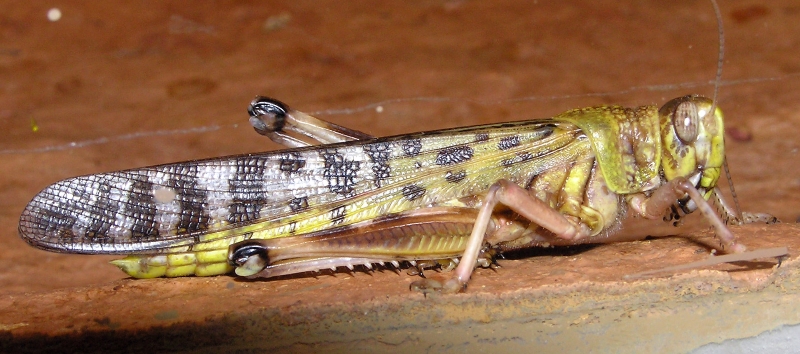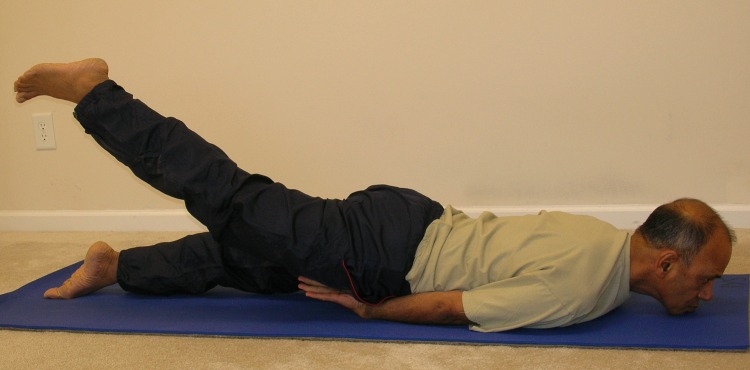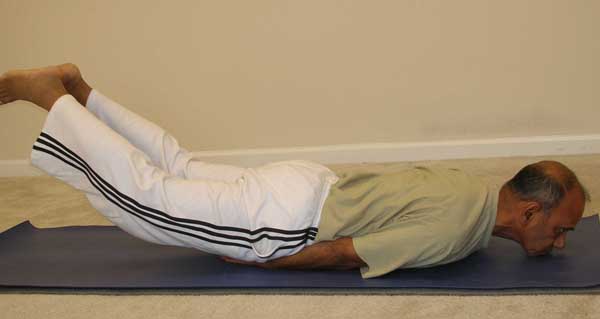
Locust – desert
Shalabhasana (Locust Pose) – शलभासन –
The word "shalabha" in Sanskrit means a locust. In the final position the pose roughly resembles a locust (grasshopper) – hence the name.
Step-by-step
I hope you will enjoy practicing with the video demonstration.
Round one – Ardha Shalabhasana (Half Locust Pose):
- Lie flat on the abdomen with the hands under the thighs, palms facing upwards. Optionally, you may make a fist with the two hands, keeping the fists together with the elbows stretched straight and tucked in.
- Keep both the legs straight and toes pointing back throughout the practice. Place the chin on the floor, slightly stretched forward to give the best possible stretch to the neck muscles and nerves
- While inhaling, using the back muscles, raise the left leg as high as possible, keeping the other leg straight, relaxed and in contact with the floor. Do not tilt or twist the pelvis
- Retain the position for four to five breaths or as long as comfortable without causing any strain
- While exhaling, lower the leg slowly to the floor and repeat the same movement with the right leg
- Repeat the above routine once more on both sides

Ardha Shalabhasana (Half Locust)
Round two – Shalabhasana (Full Locust Pose):

Shalabhasana (Locust Pose))
- Repeat steps 1 and 2 as above
- While inhaling, using the back muscles, lift both the legs together slowly, raising the legs as high as possible. Retain the final position for four to five breaths or as long as comfortable.
- Lower the legs to the floor while exhaling and repeat the above routine one more time
- As a variation to the above, you may stretch the hands back and lift your head/chest as well as the legs at the same time
Contraindications/Cautions
- Throughout the pose, maintain awareness on the spine and the breath. If at any time you feel discomfort in the spine, or any other part of the body, you should back off and come out of the pose.
- People with a weak spine should avoid the full Locust Pose and practice only a gentle version of the Half Locust Pose.
- Those with a weak heart, coronary problems, or high blood pressure should either avoid practicing Shalabhasana or practice under expert guidance.
- Avoid this pose if you suffer from peptic ulcers, hernia, intestinal problems, recent or chronic back injury, or headache.
- It is not advisable for pregnant women, except for experienced yoga practitioners who can continue to practice it gently (only the Half Locust version, never attempting the full locust) during the first trimester only.
Benefits
- Excellent pose for stretching the back muscles. The half locust can bring instant relief from mild low back pain.
- Alleviates disorders of the stomach and bowels, cures flatulence, improves digestion, promotes peristaltic action and helps with constipation
- Offers relief in cases of sciatica, slipped disc, varicose veins, hemorrhoids and lower back pain
- Excess fat is reduced especially from the hips, waist, posterior, thighs, and the abdomen.
- Various organs and glands like the reproductive organs as well as the adrenal and prostrate glands are activated
- Stimulates and helps balance the swadhisthana (2nd) and manipura (3rd) chakras
Thanks a lot Subhashji.
Both me and my wife(Gayatri Giri) have taken up Yoga in full earnestness for a couple of months. My wife has just joined a Yoga Teachers’ Training course of 200 hours in the same institute(SAMUTKARSH,Ahmedabad) from where she has been doing basic and advanced yoga sessions for more than 7 months.
I am doing basic Nitya Yoga and am tremendously enjoying the experience.
Thanks and regards,
Rajesh Gopal
Dr. Rajesh,
Thanks for sharing your yoga practice and experience. I wish all the best for your wife, Gayatri’s, teacher training program.
I have started Yoga sessions just 5 months back.Wish to know precautions in /avoidance of all the Asanas with a person with moderate hypertension(raised BP) on regular medication with full control of blood pressure.
Regards and best wishes,
R.Gopal.
Hello Rajesh,
If your BP is fully controlled with medication, you should be able to do all the practices of asana and pranayama. The only practice you may want to avoid is the pranayama called Bhastrika. I am myself in the same category – BP under control with medication – and I have been doing all the asana and pranayama practices with the exception of Bhastrika with no adverse effect.
Hello dear sirs,I used to practice yoga off and on throughout my life’a series of events kept me away of practicing, I just know the feelings of well being that are experienced just by doing the asaNAS and the OM MANTRA’, but after a short time I began experiencing a completely whole and energized,but the greatest experience that I felt was a sense of connection with everything around me and a conection with my inner self and at times i felt as one with the whole essence of creation,I now live in Hialeah, Fiorida,USA. but I feel now that I need some kind of a push, I don’t know if this has anything to do with me wanting to return and get out of depression, but I felt the sense of a need to change and I started drawing the om symbol everywere,in my calendar,my agenda and I was just doing it unintentionally,then a week ago, I started wearing on my neck a pendant that I had bought but did not feel like wearing it, I started having dreams that I had not experienced for a long time and now I feel as if I need to return to the path I had deviated from,I just want to keep that feeling of life again,thank you very much for helping humanity,could you ask that person who lives in Hialeah if it can get in touch with me?but it is not allowed ,it is all right,
once again, thank you very much,
Rene
Hello Rene,
thanks for your note. I am not sure I understand your question. Do you mind rephrasing it? Thanks.